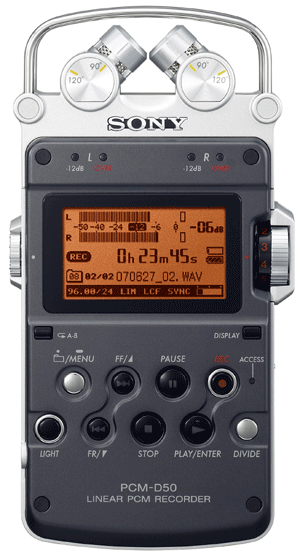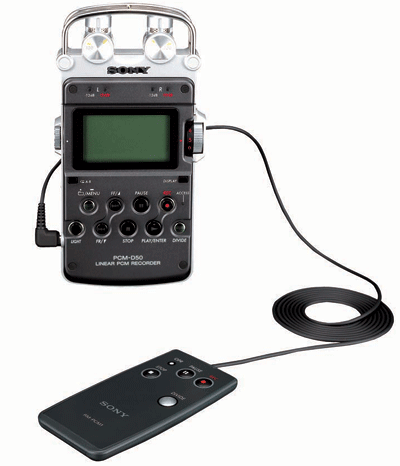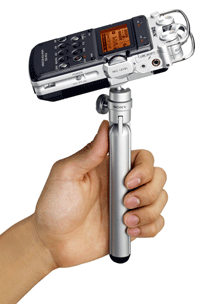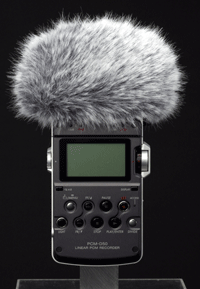
Barry's Mix Magazine Equipment And Software Reviews
Barry's Massive Discography And Engineering Career
Barry's Music Connection Magazine Reviews
Barry's Resolution Magazine Reviews
Sony PCM-D50
By Barry Rudolph

Sony's new handheld PCM-D50 recorder reprises most of the features and performance of the company's much-higher-priced PCM-D1 in a smaller-sized unit that's also "smaller" in price: $599 MSRP. The D1's titanium case, rechargeable battery system and round mechanical peak meters have been replaced with an all-aluminum enclosure, four AA battery powering and included AC power supply--but essentially the compact version offers the same peak-reading and backlit LCD. The D50 is about one-third the weight of the D1, yet it retains the same "point-and-capture" design, using a pair of swiveling electret cardioid condenser mics for either 90-degree X/Y stereo or 120-degree wide positioning. The unit also has a powerful headphone output, external mic input, and both analog and optical digital I/O facilities. 4GB Of MEMORY The D50 records PCM audio to internal 4GB Flash memory; additional storage becomes possible when you insert a Sony Memory Stick into a slot on the side--only Pro HG Duo™ sticks work. The unit records and plays .WAV format digital audio at 16 or 24-bit depths at 22.05/44.1/48/96kHz sample rates. Audio files can be on/off-loaded to the unit via an included USB 2.0 cable with PC and Mac support, including Leopard 10.5. Also included are a copy of Sound Forge Audio Studio LE editor and a Windows 2000 driver. The D50 retains both the D1's stereo limiter with a choice of three different release times (150 ms, 1 second and 1 minute) and the great-sounding Digital Pitch Control (DPC), where playback audio speed can be changed from +100 to -75 percent without pitch change. The five-second prerecord buffer function captures audio you'd normally miss if you were late going from Record Pause mode into Record; you'll never miss the beginning of a song or the first words of a speech. The D50's internal recording folder structure has 10 folders capable of holding up to 99 tracks (recorded files) each or 990 total for the internal 4GB Flash memory or any additional Memory Stick. "Pecking" the Menu button displays the folder that is currently in use. This is the first of only two menu layers; here you can search/delete individual files or select other folders. As an organizational aid and to facilitate file importation, I used a separate folder for all recordings made at similar sample rates. Renaming folders is not permitted but, after connecting your computer, you can rename the individual files and they'll show up in the D50's display. The D50 will also hold up to 500 playback-only folders with up to 5,000 files. WORKING IN THE FIELD 
For sonic evaluation, I transferred all field recordings to my Pro Tools rig. Upon connection to the Mac, the D50 shows up as a hard drive, and the Mac's Image Capture utility allowed off-loading the files right into my Music folder, but you can also drag and drop files anywhere. For all my recordings, I tried both the X/Y mic position and the wide setting. The former is more mono-compatible and best for single-point source recording such as a lecturer, but for music I found it too narrow sounding. I preferred the wider mic setting in all cases. I recorded an acoustic guitar using close proximity to produce the fattest sound that was not overly bright. The green (-12dB) and red (-1dB) headroom LEDs make it simple to set optimal recording levels; the remaining headroom is always indicated on the LCD screen. The backlit LCD was a bit dim for my taste, but it was perfectly usable in darker rooms. The D50 has a tremendous amount of mic gain available making it perfect for ambient, nature, or Foley recordings--you can actually record your own footsteps on carpet. This comes with a caveat: while in this high gain mode, any shock or handling noise of the D50 is also recorded. I'd buy the VCT-PCM1 Tripod Stand ($69.95MSRP) to isolate and elevate the unit above any surface. Resting the unit on a table top affects the frequency response of the microphones noticeable. I recorded an acoustic guitar both 18-inches and 8-inches away. The closer proximity produced fat sound that was clear and natural. Without a doubt, the acoustic guitar recording was of studio quality. I used the limiter with 150ms recovery time but not with the -24dB low-cut filter that's adjustable to either a 75- or 150Hz corner frequency. Both of these processors switch in/out via slide switches on the back of the unit--a nice touch although, in the dark, these switches along with the -20dB pad on the side of the unit, are hard to find and know their status. Setting the low-cut filter, the limiter and other parameters requires diving into the second layer of the LCD menu. Holding the Menu button down reveals where you set sample rate/bit depth, DPC, Super-Bit Mapping (SBM), prerecord buffer, clock and more. I found the backlit LCD display a bit dim for my taste although perfectly usable in darken rooms.
My next recording was 25 feet away from a blues band in a noisy bar. I tried the -20dB pad, but it made setting an exact level a little touchy as compared to using no pad. It would make a nice update to illuminate the record level knob either by allowing light from the display to spill onto it or by just adding a 1-to-10 indicator in the LCD screen. As with the acoustic guitar recording, I used 96kHz/24-bit, the limiter, wide mics and no pad, as the resultant recordings were more dynamic sounding without the pad. The limiter is very gentle and unobtrusive, and it allows for higher average recording levels-- I would recommend always using it. The band recording was the way they sounded in the room-- a good and clear documentation of a sonic event. I filled up the memory with one hour and fifty minutes of music at 96kHz/24-bit stereo. My last recording was for an oral history project at 22.05kHz/16-bit with the limiter at 1-minute recovery, low-cut filter at 75 Hz and wide mics. One mic was pointed at me and the other was pointed at my 95-year-old mother. The results were great with super clarity and minimal background noise. The long recovery time Limiter setting, by prolonging gain reduction, helps to keep the background at bay unless nobody says anything for a minute! At this sample rate and bit depth I could have recorded nearly 13 hours continuously and that's less than the operating life of the AA batteries. Later, using BIAS Peak 5 XT stereo editor software, I compressed each channel separately before mixing and posting online. While recording and during subsequent playbacks, I used the unit's Divide feature to do on-the-fly file splitting to separate each of my mom's stories into individual files. AFFORDABLE PORTABLE 

Sony's PCM-D50 provides a wonderful path to pristine digital recording in a self-contained, portable package. It's nearly idiot-proof and includes a large complement of accessories. There are few tasks, from casual to fully pro, that this unit cannot easily handle and produce excellent results. Thanks to guitarist Dean Parks for his participation in this report. Download two short recordings made of Dean at the links below. The only processing used was normalization of the files. These two clips are copyrighted D. Parks © 2008 Mics set to the narrowest position Barry Rudolph is an L.A.-based recording engineer. Visit his Web site at: WWW.BARRYRUDOLPH.COM |
|
|
|
All Web Page Design Is Copyright © 2008 through By Barry Rudolph